Orange birds are a diverse group of birds found in North America. These birds are known for their bright orange or yellow plumage which is strikingly beautiful and easily recognizable. They belong to different bird groups and can be found in various habitats across the continent.
In this article, we will provide an overview of orange birds in North America, including their common species, habitats, geographical distribution, feeding habits, and more.
Key Takeaways
Orange birds are a diverse group of birds found in North America with bright orange or yellow plumage.
Some of the most common orange birds in North America include the Baltimore Oriole, Flame-Colored Tanager, Western Tanager, and American Robin.
Orange birds can be found in different habitats and have developed different feeding habits and diets to survive.
Common Orange Birds
North America is home to a diverse range of bird species, including some striking orange birds. This section will cover some of the most common orange birds found in North America.
Baltimore Oriole


| Feature | Measurement |
|---|---|
| Scientific Name | Icterus galbula |
| Length | 6.7–8.7 in |
| Wingspan | 9.1–12.6 in |
| Weight | 22.3-42 g |
The Baltimore Oriole is a stunning bird, best known for its vibrant coloration and its rich, whistling song.
Appearance: The male Baltimore Oriole is notable for his bright orange and black plumage and black and white wing bars, a stark contrast to the more muted yellow-brown coloration of the female. Both sexes, however, have long pointed bills and white bars on their wings.
Diet: Baltimore Orioles have a diverse diet that includes insects, fruits, and nectar. Their preference for sweet juices and fruit pulp often brings them to backyard feeders offering oranges and jelly.
Reproduction: The female Baltimore Oriole is responsible for building the distinctive hanging nest, often woven together from fine materials like hair and grass. These nests are usually high in trees to avoid predators. The female lays 3-7 eggs, which are incubated for about two weeks.
American Robins


| Feature | Measurement |
|---|---|
| Scientific Name | Leptotila plumbeicep |
| Length | 10.6-11.8 in |
| Wingspan | — |
| Weight | 160-200 g |
The American Robin is a widely recognized bird species known for its melodious song and early bird tendencies.
Appearance: American Robins are medium-sized birds with a distinctive appearance. Both males and females sport a gray to brown back and a warm red to orange breast and belly and gray wings. They also have a characteristic white eye-ring and a black head, but males are usually darker than females.
Diet: American Robins have a diverse diet that changes depending on the season. In summer, they feed heavily on earthworms, beetles, and other invertebrates, which they catch on the ground. During winter, they mostly eat fruits and berries.
Reproduction: American Robins usually build their nests in trees or shrubs, but they are also known to nest on human-made structures. The female lays a clutch of about 3 to 5 eggs, which she incubates for about 12 to 14 days.
Barn Swallow

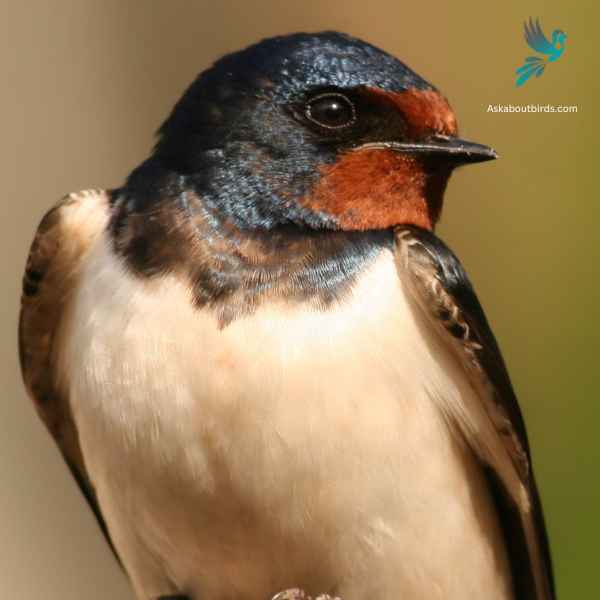
| Feature | Measurement |
|---|---|
| Scientific Name | Hirundo rustica |
| Length | 6.5–7.5 in |
| Wingspan | 12.5–13.5 in |
| Weight | 16–22 g |
The Barn Swallow is a sleek, agile bird renowned for its graceful flight patterns and iconic forked tail, often seen darting over fields and water bodies in search of flying insects.
Appearance: Barn Swallows have deep blue, almost iridescent, upperparts and a rufous to tawny underbelly. Their distinctively forked tail and long wings give them a streamlined look. Both males and females have a similar appearance, though males often exhibit slightly brighter colors and a deeper fork in the tail.
Diet: Barn Swallows feed primarily on flying insects, which they catch in mid-air during their agile and acrobatic flights. Their diet includes flies, beetles, moths, and other small flying insects.
Reproduction: Barn Swallows are known for building their mud nests on man-made structures, particularly barns, bridges, and eaves. The nest is cup-shaped and made from mud pellets, often lined with feathers. The female lays a clutch of 4 to 6 eggs.
Orchard Oriole
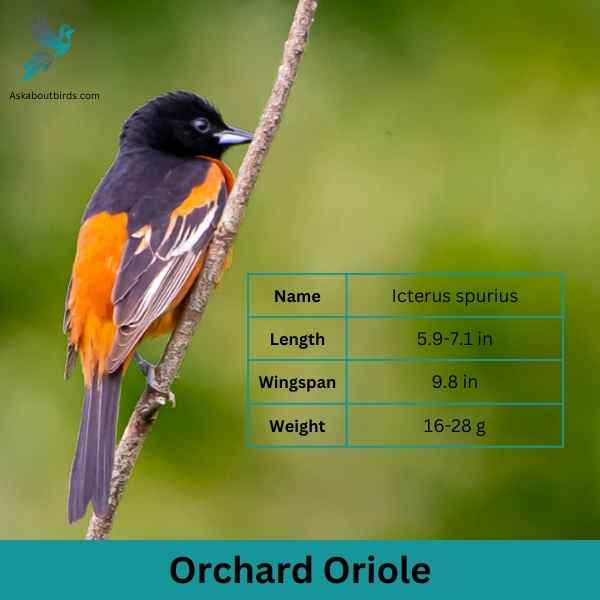
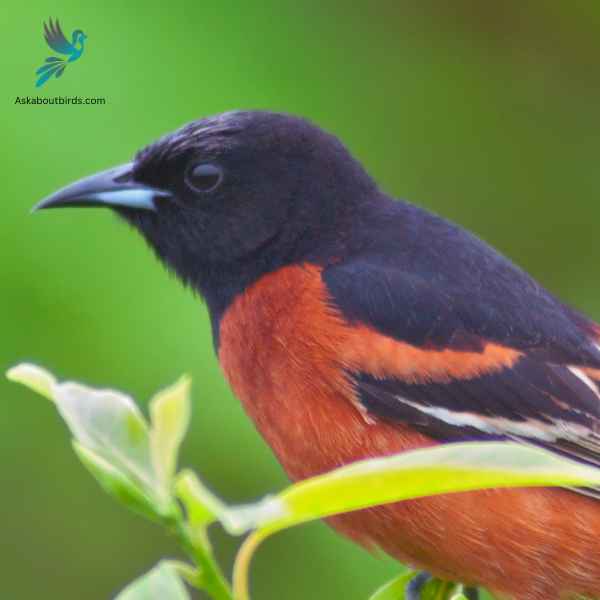
| Feature | Measurement |
|---|---|
| Scientific Name | Icterus spurius |
| Length | 5.9-7.1 in |
| Wingspan | 9.8 in |
| Weight | 16-28 g |
The Orchard Oriole is a small songbird noted for its distinctive coloration and melodic song.
Appearance: Male Orchard Orioles are a striking sight with their dark chestnut body and black head and black and white wings, while females and immature males are olive-green and feature a yellowish underpart. The species is often recognized by its slender body and pointed bill.
Diet: The diet of the Orchard Oriole consists primarily of insects, fruits, and nectar. They are adept at catching insects mid-air and are also known to sip nectar from flowers, aiding in pollination. When fruits are in season, they make up a substantial portion of the bird’s diet.
Reproduction: Orchard Orioles often nest in open woodlands and orchards, hence their name. The female is responsible for building the nest, typically choosing a location in a tree or shrub. The female lays a clutch of 4 to 6 eggs, which she incubates for about two weeks.
Black-headed Grosbeak

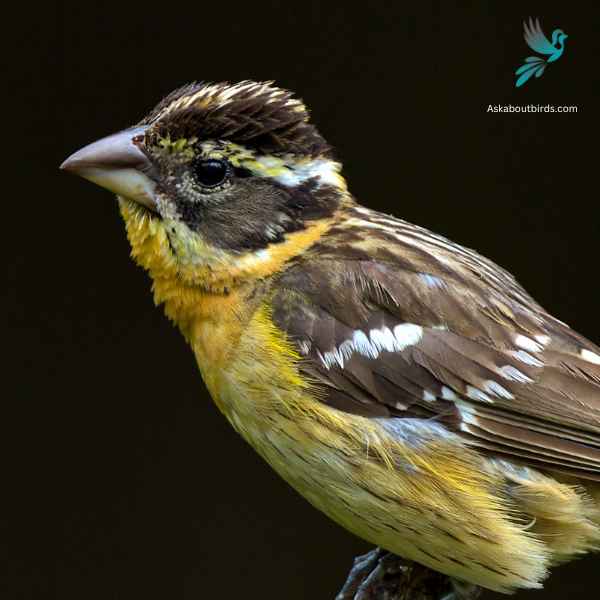
| Feature | Measurement |
|---|---|
| Scientific Name | Pheucticus melanocephalus |
| Length | 7.1–7.5 in |
| Wingspan | 12.6 in |
| Weight | 34–48 g |
The Black-headed Grosbeak is a vibrant songbird known for its melodious song, often confused with that of the American Robin but more rich and varied.
Appearance: Males are recognizable by their orange chest, black head, and black and white wings. Females, on the other hand, have a streaked brown appearance, resembling large sparrows but with hints of orange on their sides and flanks.
Diet: Black-headed Grosbeaks primarily feed on insects, seeds, and fruits. They are especially fond of beetles and caterpillars, and they’re one of the few birds that can eat monarch butterflies without suffering from the toxins.
Reproduction: They often nest in deciduous trees or shrubs. The nest is a loose, cup-like structure made from twigs and grasses. The female usually lays 3 to 4 eggs, which she incubates. Both parents share the responsibility of feeding the chicks.
Varied Thrush
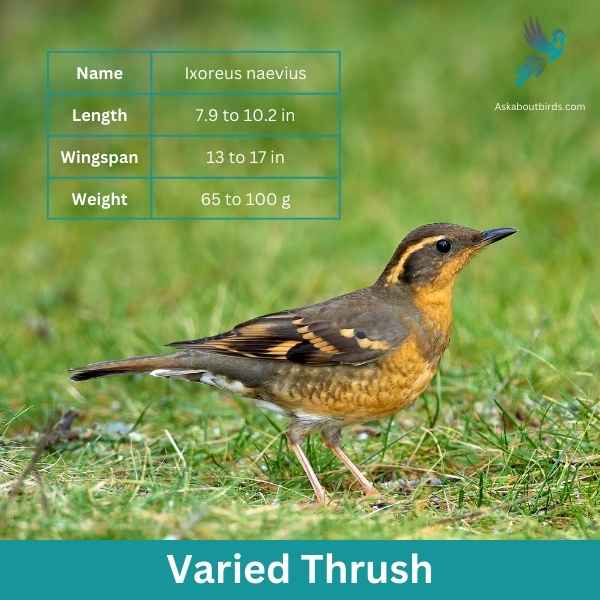

| Feature | Measurement |
|---|---|
| Scientific Name | Ixoreus naevius |
| Length | 7.9 to 10.2 in |
| Wingspan | 13 to 17 in |
| Weight | 65 to 100 g |
The Varied Thrush is a songbird known for its striking appearance and melodious, haunting song that echoes through the dense forests of the Pacific Northwest.
Appearance: The Varied Thrush has a bold pattern. Males display a blue-gray upper body, contrasted with an orange throat and breast, and a black band that extends from the eyes to the neck. The wings have two orange bands and the belly is usually lighter. Females have a similar pattern but are generally more muted in color.
Diet: Varied Thrushes primarily consume insects, berries, and seeds. Their diet can shift seasonally, with insects being more prevalent in the warmer months and berries and seeds making up the bulk of their diet in colder months.
Reproduction: Varied Thrushes nest in trees, often close to the trunk and concealed by dense branches or foliage. The female typically lays a clutch of 3 to 5 eggs, which she incubates.
Blackburnian Warbler
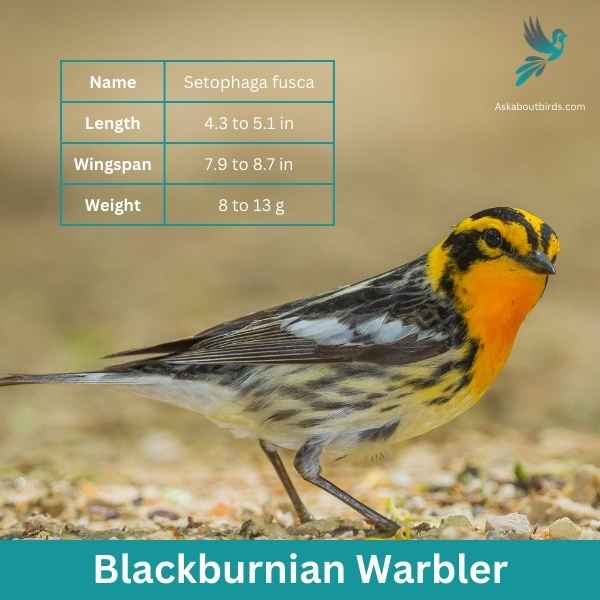

| Feature | Measurement |
|---|---|
| Scientific Name | Setophaga fusca |
| Length | 4.3 to 5.1 in |
| Wingspan | 7.9 to 8.7 in |
| Weight | 8 to 13 g |
The Blackburnian Warbler is a strikingly colored songbird that captivates observers with its vivid plumage, especially during the breeding season. Often found flitting high in the treetops of North American forests, its melodious song is as enchanting as its appearance.
Appearance: Male Blackburnian Warblers are distinguished by their fiery-orange throats, contrasting sharply with a black face, crown, and streaked back. They also have white underparts with black streaks on the sides. Females have a more muted coloration, with a yellowish or pale orange throat and less pronounced streaking.
Diet: Blackburnian Warblers primarily feed on insects and spiders. They are adept at foraging in the canopy, where they glean insects from the surface of leaves and branches or catch them mid-air in quick, agile flights.
Reproduction: Blackburnian Warblers build their nests high up in coniferous trees, often on horizontal branches. The nest is a neat cup made of twigs, grass, and moss, lined with softer materials like hair or feathers. The female lays a clutch of 4 to 5 eggs and takes the lead in incubation.
American Redstart


| Feature | Measurement |
|---|---|
| Scientific Name | Setophaga ruticilla |
| Length | 4.3 to 5.5 in |
| Wingspan | 6.3 to 9.1 in |
| Weight | 8.6 g |
The American Redstart is a lively warbler known for its vivid colors and active hunting style, often seen flitting about, fanning its tail to startle and catch insects.
Appearance: Adult male American Redstarts boast striking black plumage with bright orange patches on the sides, wings, and tail. Females and immature males have grayish-olive upperparts with yellow patches in the same areas where the males display orange.
Diet: American Redstarts are primarily insectivores. They actively forage for flying insects, as well as caterpillars and spiders, often using their colorful tails to startle prey and make them easier to catch.
Reproduction: The female American Redstart builds a cup-shaped nest in the fork of a tree branch. Typically, she lays a clutch of 3 to 5 eggs. The female takes on the primary responsibility of incubating the eggs, while both parents participate in feeding the fledglings after they hatch.
Altamira Oriole

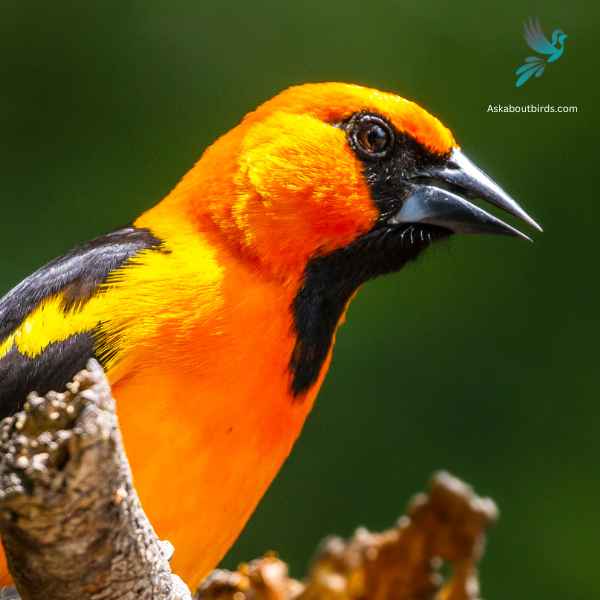
| Feature | Measurement (Imperial) |
|---|---|
| Scientific Name | Icterus gularis |
| Length | 9.1-9.4 inches |
| Wingspan | 9.1-9.4 inches |
| Weight | 2.1-2.4 oz |
The Altamira Oriole is a vibrant and melodious bird known for its contrasting black and orange plumage, predominantly found in northeastern Mexico and the southern tip of Texas.
Appearance: The Altamira Oriole boasts a bright orange body with a black throat, face, wings, and tail. The wings have two white bars and the tail often shows a pointed appearance. Both males and females have similar plumage, though males are generally slightly larger.
Diet: Their diet consists primarily of insects, fruits, and berries. They forage methodically, often probing into foliage or bark crevices to extract insects, spiders, and other arthropods. They are also known to consume nectar from flowers.
Reproduction: Altamira Orioles are known for their intricately woven, pendulous nests which can be over two feet in length. These nests are typically attached to the tips of tree branches, ensuring they are difficult for predators to access.
Spot-breasted Oriole
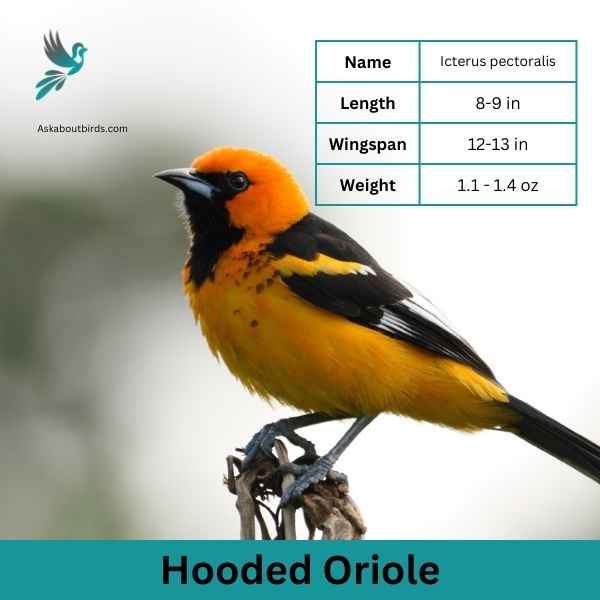
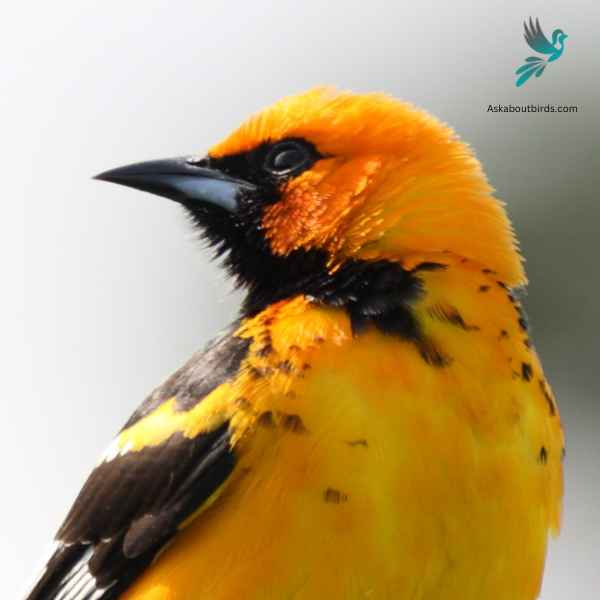
| Feature | Measurement |
|---|---|
| Scientific Name | Icterus pectoralis |
| Length | 8-9 in |
| Wingspan | 12-13 in |
| Weight | 1.1 – 1.4 oz |
The Spot-breasted Oriole is an attractive bird, native to Central America but has been introduced and established itself in certain parts of the United States, particularly in Florida.
Appearance: This oriole showcases a striking combination of colors with its bright orange body and distinctive black spots on its breast and throat. Its wings and tail are black, contrasting sharply with its vibrant body color. The beak and eyes are also black, adding to its distinctive appearance.
Diet: Spot-breasted Orioles feed primarily on a variety of insects, fruits, and berries. They are also known to consume nectar from flowering plants and can sometimes be seen at backyard fruit feeders.
Reproduction: These orioles typically build hanging basket-like nests on tree branches. Once hatched, both parents play an active role in feeding and caring for the chicks until they fledge.
Northern Red Bishop


| Feature | Measurement |
|---|---|
| Scientific Name | Euplectes franciscanus |
| Length | 4.7-5.5 in |
| Wingspan | 7-8 in |
| Weight | 25-40 g |
The Northern Red Bishop, also known as the Orange Bishop, is a small and brightly colored bird that belongs to the weaver family. It is scientifically known as Euplectes franciscanus.
Appearance: The Northern Red Bishop is a small, strikingly colored bird. Breeding males boast a brilliant orange-red body with black detailing on the belly and wings, while their forehead is strikingly red. Non-breeding males and females have a more subdued brown color, which provides effective camouflage in tall grasses or shrubs.
Diet: This adaptable bird primarily feeds on seeds, but also incorporates insects into its diet. This varied diet allows it to thrive in diverse habitats, from grasslands and wetlands to agricultural areas and even urban gardens.
Reproduction: During the breeding season, male Northern Red Bishops put on an eye-catching display to attract females. They puff up their bright feathers, ascend into the air, and descend slowly while singing a mating song. Females, attracted by these displays, mate with the males, after which they lay eggs and take care of the young.
Western Spindalis

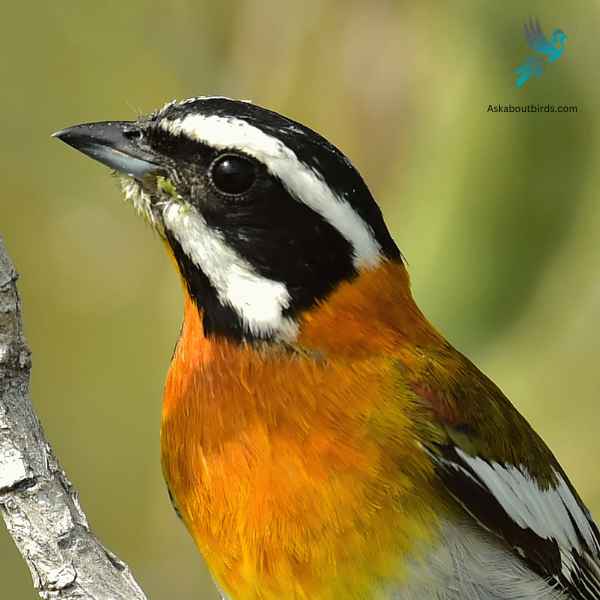
| Feature | Measurement |
|---|---|
| Scientific Name | Spindalis zena |
| Length | 5.9–6.7 in |
| Wingspan | 8.7–9.8 in |
| Weight | 0.85–1.06 oz |
The Western Spindalis is a colorful songbird known for its vibrant plumage and distinctive calls.
Appearance: The male Western Spindalis boasts a striking appearance, with a combination of bright orange on its throat and underparts, contrasted by its black and white streaked back and wings. Females and juveniles are more subdued in coloration, primarily olive-yellow with dark streaks on the back.
Diet: Western Spindalis feeds primarily on fruits, berries, and seeds, but it will also consume insects, especially during the breeding season. They often forage in the upper parts of trees, hopping from branch to branch in search of food.
Reproduction: Nesting typically occurs in shrubs or trees, with the female constructing a small cup-shaped nest. The female lays a clutch of about 2 to 3 pale blue or greenish eggs, which she incubates. Both parents take turns feeding the chicks once they hatch.
Rufous Hummingbird


| Feature | Measurement |
|---|---|
| Scientific Name | Selasphorus rufus |
| Length | 3.1–3.9 in |
| Wingspan | 4.3 in |
| Weight | 0.1–0.2 oz |
The Rufous Hummingbird is a small, brilliantly colored bird known for its impressive migratory journeys and feisty behavior.
Appearance: The male Rufous Hummingbird boasts a gleaming orange-red body with a white chest and an iridescent red throat, called a gorget. The female has green upperparts with rufous-washed flanks and tail. Her throat may have some iridescent patches, but it’s generally whitish.
Diet: Like other hummingbirds, the Rufous Hummingbird primarily feeds on nectar from a variety of flowering plants. They also eat insects and spiders for protein, catching them in flight or plucking them from vegetation.
Reproduction: Rufous Hummingbirds nest in trees, shrubs, or even ferns. The female alone selects the site, builds the nest, and cares for the offspring.
Habitats of Orange Birds
Orange birds in North America can be found in a variety of habitats, ranging from open woodlands to forests, parks, backyards, fields, gardens, riverbanks, forest edges, farms, and shrublands. Each species of orange bird has its own unique habitat preferences, depending on its diet and behavior.
For example, Baltimore Orioles can be found high up in open woodland, riverbanks, and forest edges foraging for insects and fruit, and they often come to parks and backyards. Their diet is insects such as beetles, crickets, and grasshoppers as well as spiders and snails, and they help eat pest species. Orchard Orioles, on the other hand, prefer open woodlands, fields, and gardens, and feed on insects, fruit, and nectar.
The Hooded Oriole prefers to live in arid habitats such as deserts, riparian forests, and scrublands, and feeds on nectar, insects, and fruit. Similarly, the Scott’s Oriole is found in arid and semi-arid habitats such as deserts, canyons, and mesas, and feeds on insects, fruit, and nectar.
The Bullock’s Oriole can be found in open woodlands, riparian forests, and orchards, and feeds on insects, fruit, and nectar. The Western Tanager, with its bright orange and black plumage, prefers to live in coniferous forests and mountainous areas, and feeds on insects and fruit.
Other orange birds in North America include the Northern Cardinal, American Robin, and the Eastern Bluebird. These birds can be found in a variety of habitats, including forests, fields, gardens, and parks, and feed on insects, fruit, and seeds.
Geographical Distribution
Orange birds can be found in various regions of North America, including Canada, Central America, Mexico, Florida, Alaska, South America, Western North America, and the Eastern United States. The distribution of orange birds is influenced by several factors such as habitat, food availability, and migration routes.
Birds By State
Northeast
- New England
- Mid-Atlantic
Southeast
- Orange birds in Virginia
- Orange birds in West Virginia
- Orange birds in North Carolina
- Orange birds in South Carolina
- Orange birds in Georgia
- Orange birds in Florida
- Orange birds in Tennessee
- Orange birds in Alabama
- Orange birds in Mississippi
- Orange birds in Arkansas
- Orange birds in Louisiana
- Orange birds in Kentucky
Midwest
- East North Central
- West North Central
Southwest
West
- Mountain
- Pacific
In Canada, orange birds such as the Baltimore Oriole can be found in central-southern provinces during breeding season from April to July. They then migrate to Florida, Central America, and the Caribbean for winter. Similarly, in Alaska, the Blackburnian Warbler can be spotted during the breeding season from May to August before migrating to Central and South America for winter.
In the Eastern United States, orange birds such as the Baltimore Oriole and American Robin are commonly found. The Baltimore Oriole is known for its distinctive hanging nest, which it weaves from fibers. The American Robin is a familiar sight in many backyards during the spring and summer months.
In Western North America, orange birds such as the Western Tanager and Streak-backed Oriole can be found. The Western Tanager is known for its bright yellow and orange plumage, while the Streak-backed Oriole has a distinctive black and orange striped back.
In Central America and Mexico, orange birds such as the Northern Red Bishop and Brambling can be found. The Northern Red Bishop is known for its bright red plumage, while the Brambling has a distinctive orange breast.
Feeding Habits and Diet
Orange birds in North America have diverse feeding habits and diets. Many of them are omnivores and consume a variety of insects, fruits, and seeds. Some of the common food items consumed by these birds are listed below:
Fruits: Many orange birds feed on fruits such as raspberries, mulberries, cherries, bananas, and oranges. For example, the Baltimore oriole is known to feed on ripe fruits, especially oranges.
Insects: Insects such as beetles, crickets, and grasshoppers are a significant part of the diet of many orange birds. For instance, the Blackburnian warbler primarily feeds on insects, especially caterpillars.
Nectar: Hummingbirds are known for their love of nectar. They feed on the nectar of flowers such as trumpet creeper, bee balm, and cardinal flower.
Berries: Berries such as elderberries, blueberries, and blackberries are also consumed by some orange birds. For example, the American robin is known to feed on berries during the winter months.
Seeds: Some orange birds such as finches and sparrows feed on seeds. They consume a variety of seeds such as millet, cracked corn, and black oil sunflower seeds.
Ants and other insects: Many orange birds also feed on ants, bees, wasps, and other insects. For instance, the Northern flicker is known to feed on ants and beetles.
Snails: Some orange birds such as thrushes and robins feed on snails. They use their sharp beaks to extract the snails from their shells.
Overall, orange birds in North America have diverse feeding habits and diets. They play an essential role in maintaining the ecological balance by consuming various insects and pests.
Frequently Asked Questions
What North American bird has orange feathers?
One of the most well-known birds with orange feathers in North America is the Baltimore Oriole. The males have bright orange chests and bellies, black heads and backs, and white wing bars on the black wings. Females are less brightly colored, with yellowish-orange underparts and grayish-brown upperparts. Other North American birds with orange feathers include the Orchard Oriole, the Bullock’s Oriole, and the Western Tanager.
What are the orange breasted birds in North America?
There are several species of birds in North America with orange breasts, including the Baltimore Oriole, the Orchard Oriole, and the Bullock’s Oriole. The male Baltimore Oriole has a bright orange chest and belly, while the female has a yellowish-orange underparts. The Orchard Oriole has a brick-red breast and belly, while the Bullock’s Oriole has an orange-brown breast and belly.
What kind of bird has a bright orange bill?
The American Oystercatcher is a large shorebird with a bright orange bill. It is found along the Atlantic and Gulf coasts of the United States and Mexico, as well as in parts of South America. The bill is used to pry open the shells of oysters and other mollusks, which are a major part of the bird’s diet.
What is the name of the small bird with orange on top of its head?
The small bird with orange on top of its head is the Ruby-crowned Kinglet. This bird is found throughout North America, and is known for its high-pitched song and energetic movements. The male has a bright red crest on its head, which it can raise or lower depending on its mood.
What is the bird with an orange breast called?
Several birds in North America have orange breasts, including the Baltimore Oriole, the Orchard Oriole, and the Bullock’s Oriole. The male Baltimore Oriole has a bright orange chest and belly, while the female has a yellowish-orange underparts. The Orchard Oriole has a brick-red breast and belly, while the Bullock’s Oriole has an orange-brown breast and belly.
Are there any big orange birds in North America?
While there are several species of birds in North America with orange feathers, there are no large birds that are predominantly orange in color. The largest orange bird in North America is the American Oystercatcher, which is a shorebird with a bright orange bill.




